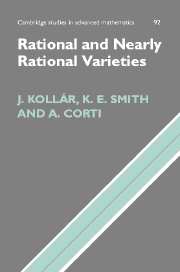4 - Nonrationality via reduction modulo p
Published online by Cambridge University Press: 25 May 2010
Summary
A smooth projective variety is said to be Fano if its anti–canonical bundle is ample. In particular, a Fano surface is simply a Del Pezzo surface. In Chapter 3, we saw that every Del Pezzo surface is geometrically rational. Over C, the obvious obstructions to rationality – such as the plurigenera – all vanish for a Fano variety of any dimension. One might wonder whether, as in the surface case, a smooth Fano variety of any dimension is always rational. The purpose of this chapter is to show that, quite to the contrary, there exist an abundance of nonrational Fano varieties of every dimension greater than two.
Our method is based on reduction to prime characteristic, where we make use of the rather special features of differential forms. By its nature, this approach yields statements only about “very general” varieties in certain families, and does not seem to be able to produce statements about, for example, all smooth hypersurfaces of a given degree. By contrast, the Noether–Fano method we later develop in Chapters 5 and 6 does yield completely general statements; we use it for instance to prove that no smooth quartic three–fold is rational. On the other hand, the reduction to prime characteristic technique here can be applied in a greater range of situations than the Noether–Fano method.
- Type
- Chapter
- Information
- Rational and Nearly Rational Varieties , pp. 93 - 121Publisher: Cambridge University PressPrint publication year: 2004

